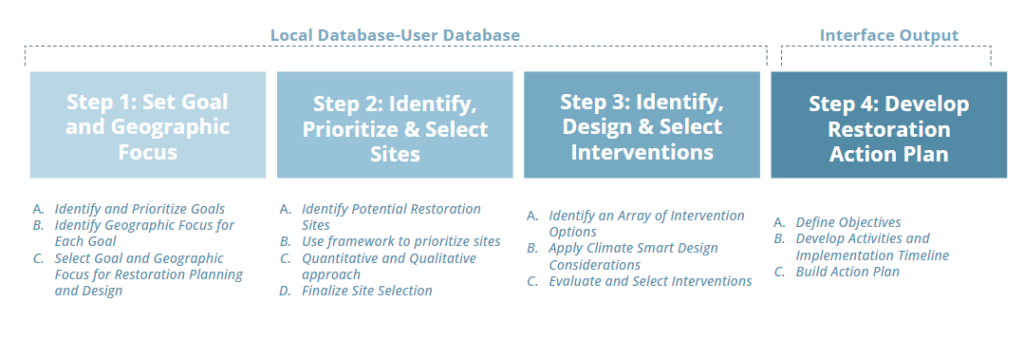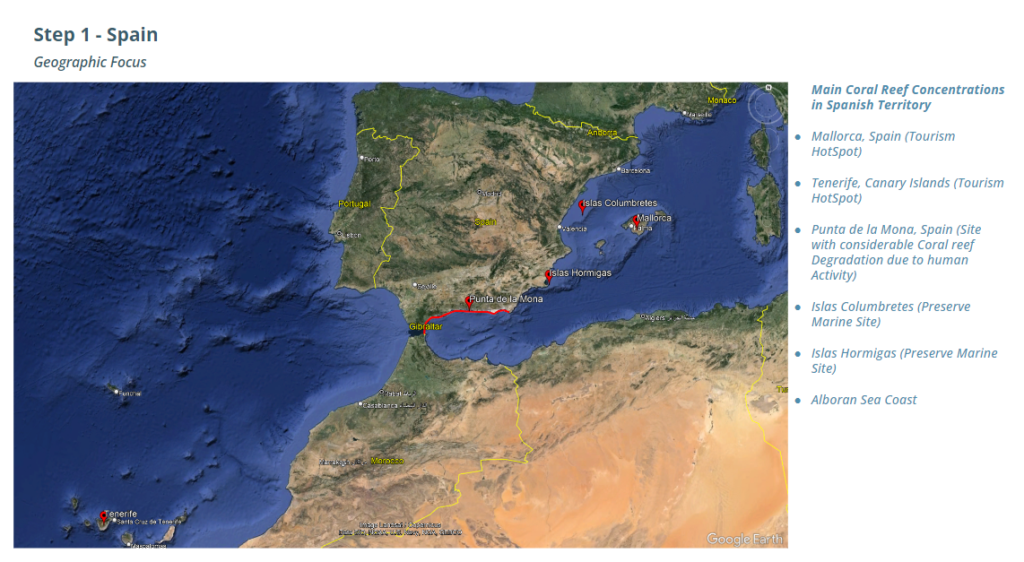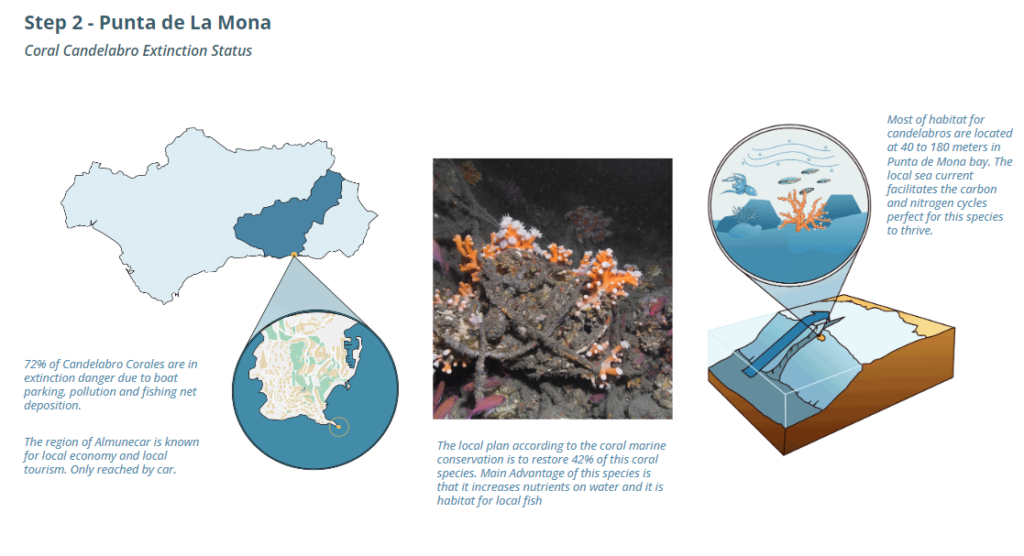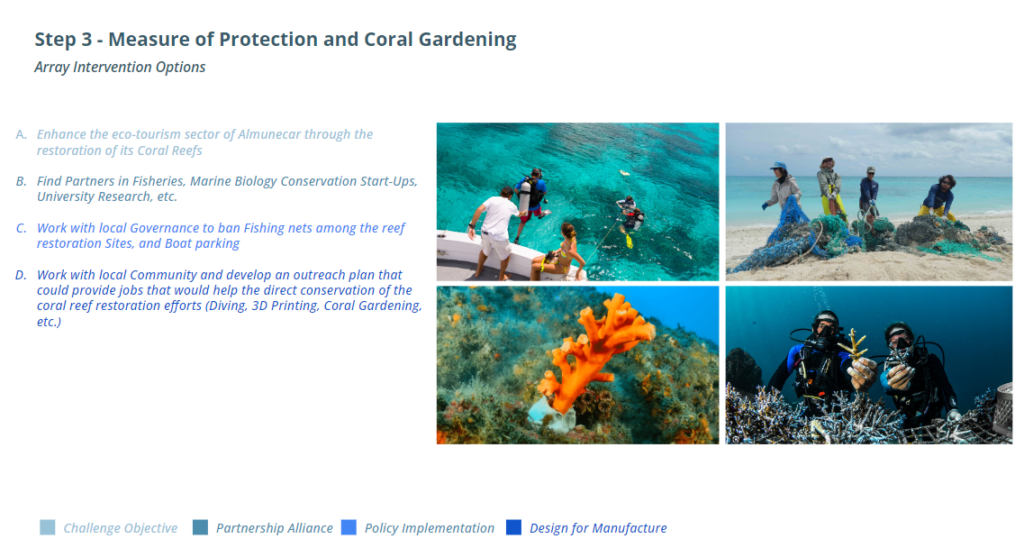Coral reefs play a pivotal role in the ocean’s capacity to sequester carbon dioxide, acting as natural carbon sinks. Through the process of calcification, corals convert carbon dioxide from the water into limestone (calcium carbonate) structures, which comprise the coral skeleton. This not only helps in reducing the amount of CO2 in the ocean but also supports the ocean’s overall health and biodiversity. Efforts to preserve and restore coral reefs are essential in the fight against climate change, enhancing their ability to decarbonize the marine environment and maintain ecological balance.
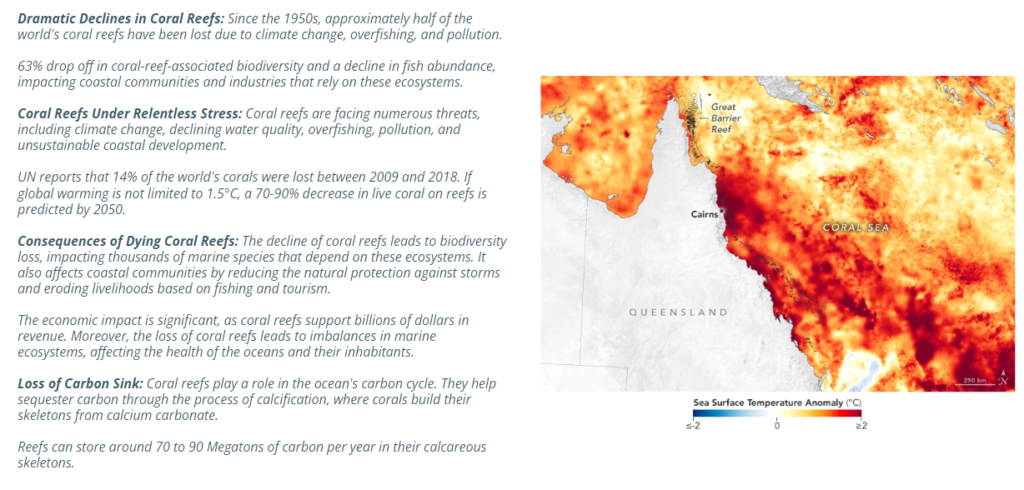
“Effects of Ocean Acidification on Corals.” Oceana USA. Accessed January 24, 2024. https://usa.oceana.org/effects-ocean-acidification-corals/.
“UNEP. ‘Why Are Coral Reefs Dying?’ United Nations Environment Programme, November 12, 2021. https://www.unep.org/news-and-stories/story/why-are-coral-reefs-dying.”
What has been produced on reef reconstruction?
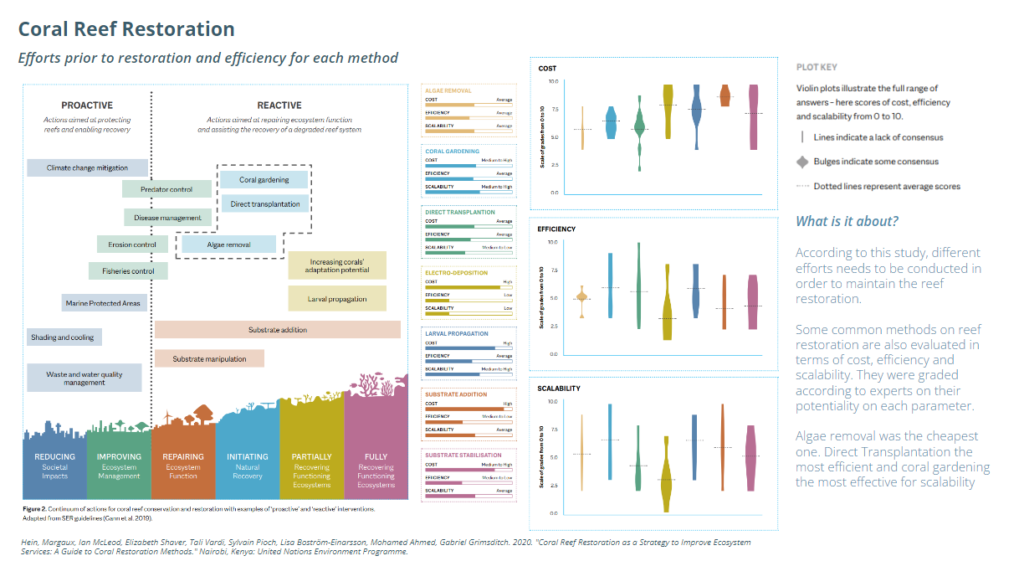
Artificial Reefs
The effect of artificial reefs on fish assemblage versus natural sites in the Bandar Lengeh-Iran
What is it about?
This article investigates the impact of artificial reefs compared to natural sites on fish assemblages. The study was conducted in the Bandar Lengeh area of the Persian Gulf and involved five treatments, including four different forms of artificial reefs (Reef ball, Laneh Mahi, used materials, and a combination of these) and one control (natural site). Fish sampling was carried out every three months for one year.
What is Interesting?
- Significant differences were found between the artificial reefs and the control sites in terms of Catch Per Unit Effort (CPUE). The mixed form of reefs showed the best enhancement of CPUE compared to other forms and the control. The study concludes that the artificial reefs deployed have successfully enhanced the fish community, indicating their potential for marine ecosystem management.
- Artificial reefs made out of concrete with formwork weighting around 2 tons

Azhdari H., Mohd Ibrahim, Aziz Arshad, Shamarina Shohaimi, Ajdari Z., Zelina Zaiton Ibrahim. 2012. “The effect of artificial reefs on fish assemblage versus natural sites in Bandar Lengeh-Iran.” Iranian Journal of Fisheries Sciences 11(1): 1-12
3D Printed Artificial Reefs
REFORMATIVE CORAL HABITATS: REEF TILES
What is it about?
The study focuses on the use of a robotic 3D clay printing method to create these structures. Unlike previous approaches that used concrete, this research utilizes clay due to its lower environmental impact and similarity to natural coral reef materials. The clay structures are designed to provide suitable microhabitats for specific coral species and prevent sedimentation, a common issue in subtropical waters. The paper details the design process, including algorithmic strategy and optimization of the printing path, to ensure structural integrity and functionality of the artificial reefs.
What is Interesting?
- The research aims to provide a more sustainable and effective solution for coral reef restoration, considering the specific marine conditions of Hong Kong. By using 3D printing technology and environmentally friendly materials, this approach seeks to create a viable habitat for corals, aiding in the recovery and preservation of these crucial marine ecosystems.
- 3D printing serves not only as mass customization for bioinformed design but also as material deposition optimization.

Lange, Christian J., Lidia Ratoi, and Dominic Lim Co. 2020. “Reformative Coral Habitats: Rethinking Artificial Reef Structures through a Robotic 3D Clay Printing Method.” In Proceedings of the 25th International Conference on Computer-Aided Architectural Design Research in Asia (CAADRIA) 2020, 463-472. Hong Kong: Association for Computer-Aided Architectural Design Research in Asia.
3D Printed Artificial Reefs
REEF DESIGN LAB
What is it about?
MARS reimagines traditional farming structures used for growing coral, such as coral trees, biorock structures, and concrete blocks, into a three-dimensional lattice that can be easily deployed and implemented by divers, similar to an underwater Lego set. This design eliminates the need for heavy-duty machinery, making it accessible to communities without such resources. Each MARS unit has a specially designed surface geometry to encourage natural recruitment of juvenile coral and facilitate the attachment of transplanted coral. These surfaces are 3D printed and molded in ceramic using the slip casting process, then filled with marine concrete and steel reinforcement. Ceramic is chosen for its inertness and ability to be molded with rough surfaces, which are ideal for coral attachment.
What is Interesting?
- The MARS project is ongoing, with trials to test its application for various other restoration purposes in different environments. The project also explores how to reduce the energy footprint of materials used for such structures. However, the team emphasizes that without significant global CO2 emissions reduction, the decline in coral reef health will continue
- 3D printing serves not only as mass customization for bio-informed design but also as material deposition optimization.

“Modular Artificial Reef Structure (MARS) – Reef Design Lab.” Accessed January 24, 2024. https://www.reefdesignlab.com/mars.
CORAL RESTORATION FOR CLIMATE CHANGE ADAPTATION IN THE SOUTH PACIFIC
Fiji, Kiribati, Tuvalu, Samoa, Vanuatu, and French Polynesia
What is it about?
Various strategies and actions taken to address the challenges posed by climate change to coral reefs in the South Pacific region, including Fiji, Kiribati, Tuvalu, Samoa, Vanuatu, and French Polynesia. It highlights the critical role of climate change as a major stressor on coral reefs, surpassing overfishing, water quality issues, and physical destruction as primary causes of reef decline. The document outlines how coral-focused climate change adaptation measures have been integrated into existing coral reef management strategies and Marine Protected Areas (MPAs) through capacity building, the establishment of coral nurseries, and restoration sites composed of bleaching-resistant corals.
What is Interesting?
- It is impossible to replant entire coral reefs, however it may be possible to jump-start natural recovery processes, and to spread bleaching resistance among coral populations.
- The tourism sector and communities can become major resources for action and progress, but training and long-term guidance is required for effectiveness.
- Post bleaching predation and subsequent mortality of the few survivors of mass bleaching can be an important factor preventing coral reefs from adapting to increasing temperatures over time.

Hein, Margaux, Ian McLeod, Elizabeth Shaver, Tali Vardi, Sylvain Pioch, Lisa Boström-Einarsson, Mohamed Ahmed, Gabriel Grimsditch. 2020. “Coral Reef Restoration as a Strategy to Improve Ecosystem Services: A Guide to Coral Restoration Methods.” Nairobi, Kenya: United Nations Environment Programme.
ECO-DESIGNED MOORING PROJECT
Deshaies bay, Guadeloupe
What is it about?
The challenge was to design a new mooring system that would ‘kill two birds with one stone’ by reducing the impacts, from boat anchors in coral reef and seagrass areas, and to enhance coral colonisation and associated fauna. The new mooring system was to integrate an eco-design approach as a Nature-Based Solution (NBS) which mimicked coral habitats and their ecological functions using methods of green engineering.
What is Interesting?
- The blocks mimicked natural roughness, pits and the shape of small caves that could be found in surrounding coral reefs
- The six years of ecological monitoring showed a return of normal growth of coral and seagrasses in the bay of Deshaies, after boating anchoring prohibition and installations of the eco-moorings. After six years, 52% of local coral species had settled on the eco-moorings, even though the total surface of the 40 mooring blocks only covered 300 m² in the bay.
- Three different models were tested to assess the capacity of different concrete treatments and surface roughness to attract coral recruits. The ‘mangroves roots’ design was by far the best for coral recruitment

Hein, Margaux, Ian McLeod, Elizabeth Shaver, Tali Vardi, Sylvain Pioch, Lisa Boström-Einarsson, Mohamed Ahmed, Gabriel Grimsditch. 2020. “Coral Reef Restoration as a Strategy to Improve Ecosystem Services: A Guide to Coral Restoration Methods.” Nairobi, Kenya: United Nations Environment Programme.
CORAL NURTURE PROGRAM
Great Barrier Reef, Australia
What is it about?
Australia’s iconic Great Barrier Reef (GBR) has experienced catastrophic loss of coral (>30%) from mass bleaching via back-to-back marine heatwaves (2016–17), with a third event underway in 2020. These unprecedented impacts solidified concerns that conventional GBR management – largely marine area protection and mitigating deteriorating water quality – was no longer sufficient to secure the GBR’s future.
What is Interesting?
- As of May 2020, over 50 nursery platforms have been established and over 17,000 corals planted across six major high-value tourism sites, as a result of the Coral Nurture Program tourism-research partnership.
- Numerous coral species (across all growth morphologies) had been impacted at GBR sites, and therefore floating platforms were designed in favour of existing ‘coral tree’ structures to consistently accommodate any taxa, but also within often physically dynamic outer reef sites
- The desire to optimise effective practice(s) tailored to the GBR has been critical in ensuring key lessons are learnt prior to initiating projects purely for commercial gain, in particular where the ecological impacts are yet to be fully resolved. Importantly, scientific rigour has been central in driving increased social licencing, learning through implementation, but under well controlled environmental and social conditions. This has been central in building trust amongst researchers, stakeholders and the wider public to better define when restoration is (and isn’t) appropriate for the GBR

Hein, Margaux, Ian McLeod, Elizabeth Shaver, Tali Vardi, Sylvain Pioch, Lisa Boström-Einarsson, Mohamed Ahmed, Gabriel Grimsditch. 2020. “Coral Reef Restoration as a Strategy to Improve Ecosystem Services: A Guide to Coral Restoration Methods.” Nairobi, Kenya: United Nations Environment Programme.
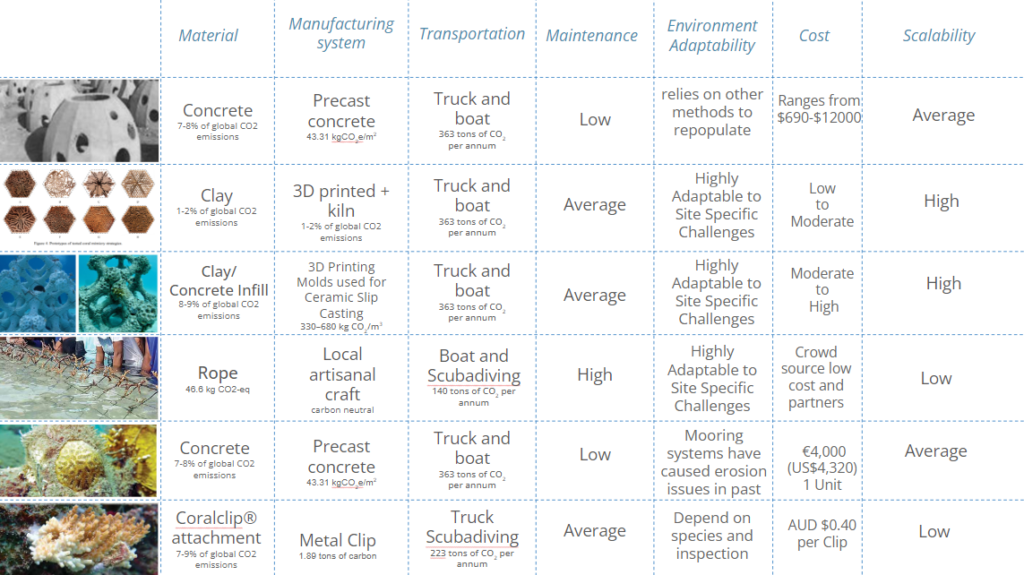

A platform (intelligence) that would generate a low carbon framework for the most optimal solution in terms of design-installation of reefs for specific locations
